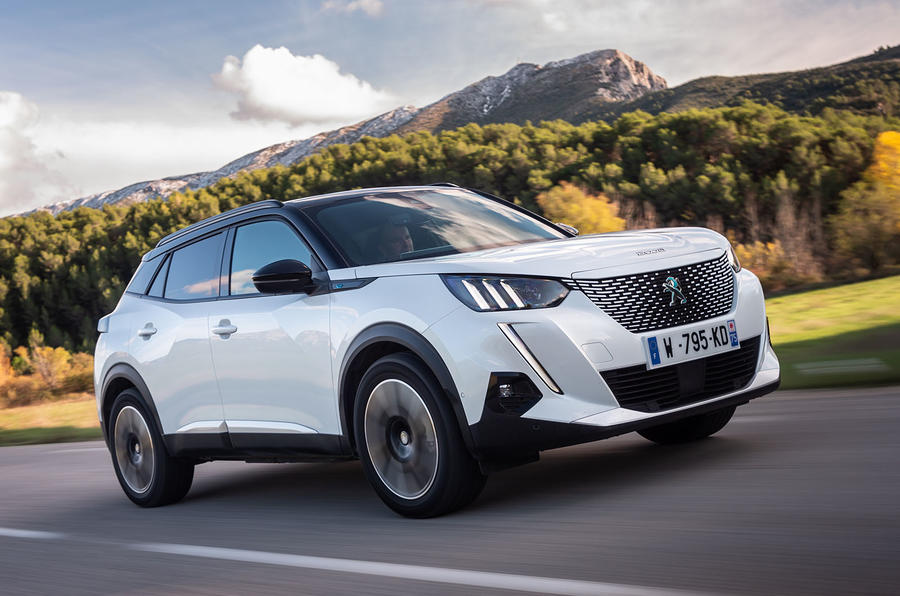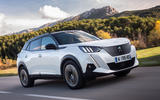What is it?
Another week, another feature that opens with the line ‘another week, another compact crossover’. A further opportunity will come in January. But this week it’s the Peugeot e-2008, the taller small Peugeot that is not quite as small as the previous 2013-2019 Peugeot 2008. At 4.3m long, it’s 15cm longer than the 2008 it replaces, so is now longer than a Volkswagen Golf.
It sits on Peugeot’s CMP (Common Modular Platform) small car architecture which, you may know, means it comes with a choice of internal combustion power or as a pure battery-electric vehicle, as tested here. Plug-in hybridisation is saved for bigger Peugeot s and Citroëns and DSs now, Vauxhalls later and who knows what beyond that, once parent company PSA Group merges with Fiat Chrysler as is planned next year.
Anyway, the idea is that, instead of Peugeot making a stand-alone electric vehicle, you choose a car from the regular Peugeot range and then choose your powertrain - ‘thermal’ or, increasingly, electric - to suit you, which strikes me as a pragmatic long-term approach. We’ve only tested the combusted and electric 2008s separately because they’re still widely searched for separately online - I guess electrification’s work will be done when searches are powertrain agnostic and the EV will have truly entered the everyday motoring lexicon.
Meantime, the e-2008 is meant to feel much like an ICE 2008. Like all big car companies, Peugeot needs a mix of low- or zero-tailpipe-emission vehicles to meet legislated CO2 targets. Its current order bank, with electrified versions into double-figure percentages, suggests it’ll meet them comfortably.
The 134bhp electric version will make up a double-digit percentage of 2008 sales, considerably more than the 99bhp manual-only diesel, which thanks to Volkswagen’s diesel cheating will likely make up just one 2008 in every 20. You can try to make a good case for a clean modern diesel, Peugeot CEO Jean-Philippe Imparato tells us, but “nobody’s listening”.
The new 2008 joins a raft of compact crossovers and, at this size and price, is pitched against rather a lot of family hatchbacks too. Other crossovers have not exactly set a high bar, but the best small family hatchbacks are really rather good.
Prices for combusted 2008s start at around £20,000 and rise to £31,000, with e-2008s costing £28,000 to £34,000 after the government grant, though lower servicing and refuelling costs on the BEV are meant to keep overall ownership costs equivalent to a 129bhp petrol.






































Join the debate
Add your comment
Certification of battery life.
A great idea to make the used market less risky in future.
Dodgy packaging
The review did not mention if there was any kind of small luggage area under the bonnet. Many magazine articles promised the brave new world of BEV promised more interior space. SUV owners invariably carry stuff and people. A 360 litre offering is only a tad more than many 4metre superminis.
The length of 4.3 metres is identical to a 2003-2010 Ford C max. That managed 550litres. Can crash protection regulations really account for this much reduction in space?
Brave new world or....
...the price of converting an ICE based car rather than a ground up design.
This really is a copy and
How it will compare with Hyundai and kias higher range EVs at a similar price point will be interesting, whether people decide they need the extra range or not.
I like the idea of ev being an option on a car as opposed to a stand alone car.
I guess the issue is that a
I guess the issue is that a platform designed to accept both ICE and BEV powertrains is inherently compromised, missing out on the packaging benefits of an electric vehicle.
For PSA this flexibility makes sense. For customers, the compelling dedicated and affordable EV awaits.
si73 wrote:
Indeed, it's an incredibly lazy article, the reviewer also seems very disparaging of the car simply because he doesn't like the type of vehicle it is, rather than judging it on its merits or lack of and it seems, reading through the lines, it's actually quite good.
Another example of the drop in quality of journalism at Autocar, which is a shame as it was once THE magazine to go for.